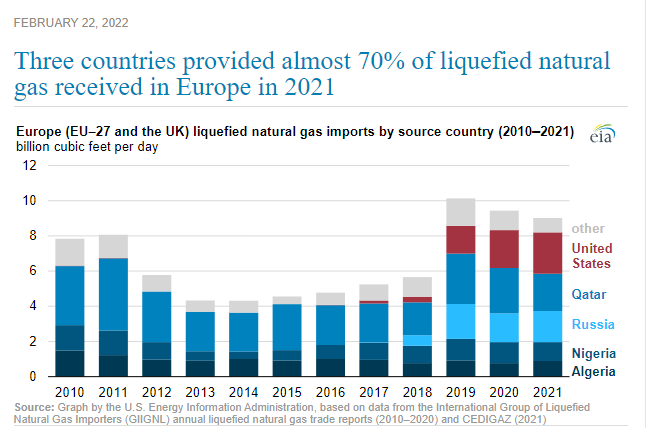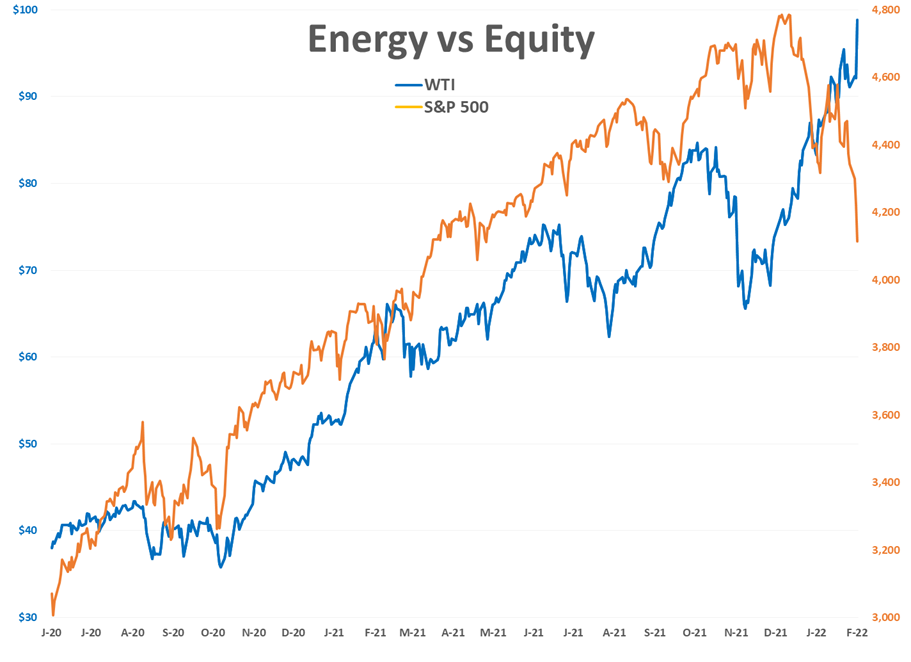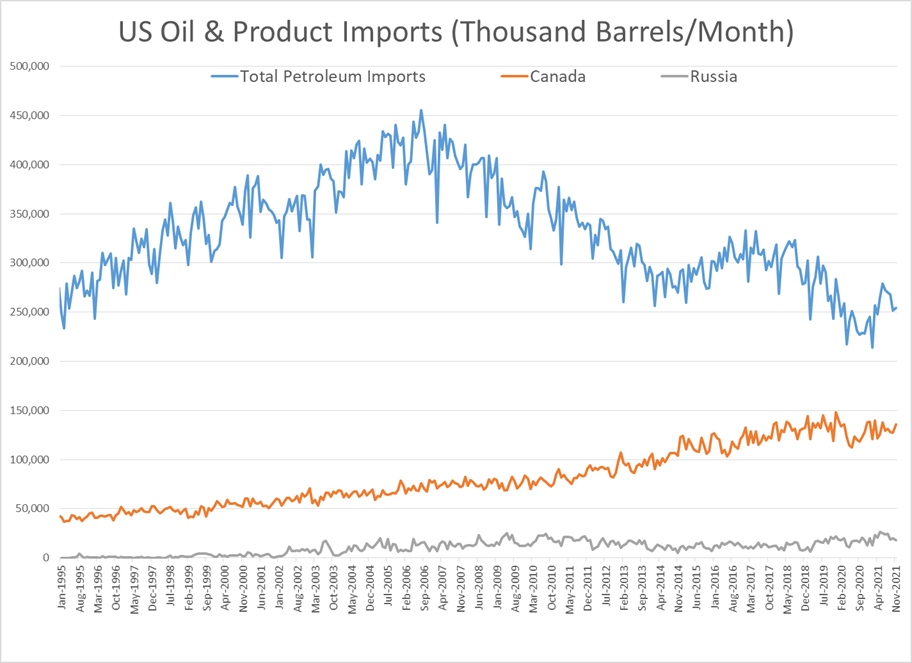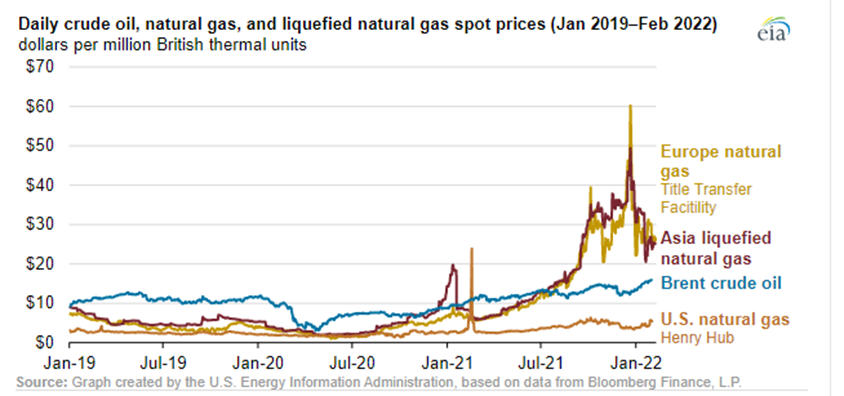Stock Markets Around The World Are Tumbling

Oil prices surged north of $100, and several RBOB and ULSD contracts traded north of $3/gallon overnight, up nearly 20 cents/gallon so far this morning, after a full-on Russian assault of Ukraine. Stock markets around the world are tumbling, as solutions to this conflict seem to all come with a high level of economic and/or human damage.
More sanctions have already been promised by the US and allied countries, and Ukraine has requested that Turkey close off the Black Sea straits, which would block Russian warships, and roughly 2 million barrels/day of oil shipments.
So, how high can prices go now? The charts show a pretty strong band of resistance for crude oil around the $110 range, which repelled rallies in 2011, 2012 and 2013, prior to prices collapsing late in 2014. For refined products there’s a wider range between $3.20-$3.40 that acted as a price ceiling during those years, that should at least act as a stopping point if this rally continues. If for some reason prices break through those chart layers, then we’d target the 2008 highs. That said, the best cure for high prices is high prices, and this latest spike may end up forcing prices lower later this year by forcing drivers off the road and travelers to reconsider their European vacations.
As the charts below show, the US does import oil and refined products from Russia, but the relatively small fraction of the country’s declining import demand should be replaceable and most likely swapped with barrels that would otherwise go to a sanctions-resistant buyer like China.
While the war in Ukraine will no doubt dominate headlines, the pipeline formerly known as Plantation was closed Wednesday to investigate a possible leak in a suburb of Atlanta. While there are no reported connections between the situations, the timing is certainly a harsh reminder that Russian hackers took the nearby Colonial pipeline offline for almost a week last year, and that new cyber-attacks should be expected if the new cold war continues to escalate. The winter storm sweeping the eastern half of the country may delay the repairs on the plantation line, but it’s also keeping many drivers off the road so it may not have as much of an impact on regional supplies if it can come back online in a day or two.
While the 7-8% increases in oil and refined product futures are obviously a big deal, they pale in comparison to natural gas prices in European markets that are up roughly 30% on the day so far. As has been widely reported over the past few months in the runup to this conflict, Europe gets roughly 40% of its natural gas supplies from Russia. The EIA this week highlighted how the US, Qatar and Russia account for 70% of all European LNG imports, but the unfortunate reality is there simply is not capacity currently to replace the Russian supplies.
Click here to download a PDF of today's TACenergy Market Talk.
News & Views
View All
The Recovery Rally In Energy Markets Continues For A 3rd Day
The recovery rally in energy markets continues for a 3rd day with refined product futures both up more than a dime off of the multi-month lows we saw Wednesday morning. The DJIA broke 40,000 for the first time ever Thursday, and while it pulled back yesterday, US equity futures are suggesting the market will open north of that mark this morning, adding to the sends of optimism in the market.
Despite the bounce in the back half of the week, the weekly charts for both RBOB and ULSD are still painting a bearish outlook with a lower high and lower low set this week unless the early rally this morning can pick up steam in the afternoon. It does seem like the cycle of liquidation from hedge funds has ended however, so it would appear to be less likely that we’ll see another test of technical support near term after this bounce.
Ukraine hit another Russian refinery with a drone strike overnight, sparking a fire at Rosneft’s 240mb/day Tuapse facility on the black sea. That plant was one of the first to be struck by Ukrainian drones back in January and had just completed repairs from that strike in April. The attack was just one part of the largest drone attack to date on Russian energy infrastructure overnight, with more than 100 drones targeting power plants, fuel terminals and two different ports on the Black Sea. I guess that means Ukraine continues to politely ignore the White House request to stop blowing up energy infrastructure in Russia.
Elsewhere in the world where lots of things are being blown up: Several reports of a drone attack in Israel’s largest refining complex (just under 200kbd) made the rounds Thursday, although it remains unclear how much of that is propaganda by the attackers and if any impact was made on production.
The LA market had 2 different refinery upsets Thursday. Marathon reported an upset at the Carson section of its Los Angeles refinery in the morning (the Carson facility was combined with the Wilmington refinery in 2019 and now reports as a single unit to the state, but separately to the AQMD) and Chevron noted a “planned” flaring event Thursday afternoon. Diesel basis values in the region jumped 6 cents during the day. Chicago diesel basis also staged a recovery rally after differentials dropped past a 30 cent discount to futures earlier in the week, pushing wholesale values briefly below $2.10/gallon.
So far there haven’t been any reports of refinery disruptions from the severe weather than swept across the Houston area Thursday. Valero did report a weather-related upset at its Mckee refinery in the TX panhandle, although it appears they avoided having to take any units offline due to that event.
The Panama Canal Authority announced it was increasing its daily ship transit level to 31 from 24 as water levels in the region have recovered following more than a year of restrictions. That’s still lower than the 39 ships/day rate at the peak in 2021, but far better than the low of 18 ships per day that choked transit last year.
Click here to download a PDF of today's TACenergy Market Talk.

Energy Prices Found A Temporary Floor After Hitting New Multi-Month Lows Wednesday
Energy prices found a temporary floor after hitting new multi-month lows Wednesday morning as a rally to record highs in US equity markets and a modestly bullish DOE report both seemed to encourage buyers to step back into the ring.
RBOB and ULSD futures both bounced more than 6 cents off of their morning lows, following a CPI report that eased inflation fears and boosted hopes for the stock market’s obsession of the FED cutting interest rates. Even though the correlation between energy prices and equities and currencies has been weak lately, the spillover effect on the bidding was clear from the timing of the moves Wednesday.
The DOE’s weekly report seemed to add to the optimism seen in equity markets as healthy increases in the government’s demand estimates kept product inventories from building despite increased refinery runs.
PADD 3 diesel stocks dropped after large increases in each of the past 3 weeks pushed inventories from the low end of their seasonal range to average levels. PADD 2 inventories remain well above average which helps explain the slump in mid-continent basis values over the past week. Diesel demand showed a nice recovery on the week and would actually be above the 5 year average if the 5% or so of US consumption that’s transitioned to RD was included in these figures.
Gasoline inventories are following typical seasonal patterns except on the West Coast where a surge in imports helped inventories recover for a 3rd straight week following April’s big basis rally.
Refiners for the most part are also following the seasonal script, ramping up output as we approach the peak driving demand season which unofficially kicks off in 10 days. PADD 2 refiners didn’t seem to be learning any lessons from last year’s basis collapse and rapidly increased run rates last week, which is another contributor to the weakness in midwestern cash markets. One difference this year for PADD 2 refiners is the new Transmountain pipeline system has eroded some of their buying advantage for Canadian crude grades, although those spreads so far haven’t shrunk as much as some had feared.
Meanwhile, wildfires are threatening Canada’s largest oil sands hub Ft. McMurray Alberta, and more than 6,000 people have been forced to evacuate the area. So far no production disruptions have been reported, but you may recall that fires in this region shut in more than 1 million barrels/day of production in 2016, which helped oil prices recover from their slump below $30/barrel.
California’s Air Resources Board announced it was indefinitely delaying its latest California Carbon Allowance (CCA) auction – in the middle of the auction - due to technical difficulties, with no word yet from the agency when bidders’ security payments will be returned, which is pretty much a nice microcosm for the entire Cap & Trade program those credits enable.





